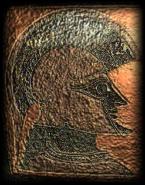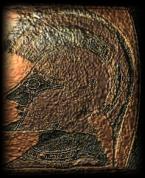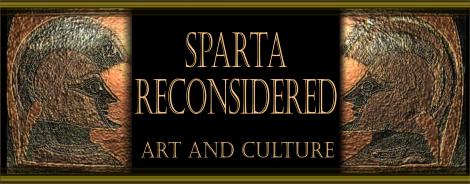
HOME
CONSTITUTION
ECONOMY
EDUCATION
ETHOS
FOREIGN POLICY
WOMEN
MARRIAGE
SEXUALITY
ART
LEONIDAS
ESSAYS
NOVELS
SOURCES
SCREEN SAVER
GUEST BOOK
AUTHOR BIO
SPARTA BLOG
AUTHOR WEBSITE
SPARTAN THEMED
T-SHIRTS, TOTES
& MORE
CONSTITUTION
ECONOMY
EDUCATION
ETHOS
FOREIGN POLICY
WOMEN
MARRIAGE
SEXUALITY
ART
LEONIDAS
ESSAYS
NOVELS
SOURCES
SCREEN SAVER
GUEST BOOK
AUTHOR BIO
SPARTA BLOG
AUTHOR WEBSITE
SPARTAN THEMED
T-SHIRTS, TOTES
& MORE


CULTURAL ACCOMPLISHMENTS:
ART, ARCHITECTURE, MUSIC, POETRY, AND DANCE
The common assumption that Sparta lacked artistic achievements is incorrect.
Pausanias, traveling through Sparta in the second century AD, recorded hundreds of significant buildings – temples, monuments, tombs, and public buildings – that were part and parcel of Spartan art and culture.
According to contemporary sources, Sparta was particularly renowned for its music and dance.
Spartan sculptors were active in pan-European sites such as Delphi and Olympia.
Spartan bronze works were coveted as gifts and imports. Spartan poets were admired throughout the ancient world – and it was one of these who wrote the first recorded heterosexual love poems known today.
Architectural Monuments
Looking first at architecture, Sparta was distinguished by its early democracy and prosperity, and by the fact that it was unconquered and unplundered until relatively late in ancient times. In short, its monuments were built early and there was no compulsion to replace them. (We should not forget that the splendor of the Athenian Acropolis is largely a function of the fact that the Persians destroyed all the older temples on the site. As a result, Pericles was able to carry out a comprehensive modernization of the entire Acropolis at the very pinnacle of Athenian power, wealth, and artistic prominence.)
Sparta did have buildings and temples, however, that were greatly admired in their own time. The most significant of these were the Menelaion and the Amyklaion. The Menelaion, which dates from roughly 700 BC, was erected as a monument or temple to Menelaos and Helen. It is located near the remains of a Mycenaean palace – allegedly the palace of Menelaos – dating roughly from the 15th century BC. The Amyklaion was admired by ancient historians as the most significant temple in all Lacedaemon. It was built in Sparta's Golden Age – the 6th century BC. This temple contained a massive bronze statue of Apollo surrounded by colonnades and stoa. Particularly worthy of mention is also the Spartan Assembly Hall, a monumental stoa built in the mid-6th century and greatly admired by visitors to Sparta. The Persian Stoa, built after the victory over the Persians in the 5th century, was later added as a counterpart on the agora and was also significant. In short, the city of Sparta had a rich, varied, and yet urban character – despite the disparaging remarks made by Thucydides.
Sculpture and Crafts in Bronze, Ivory, and Terra Cotta
There is now significant archaeological as well as historical evidence that Sparta enjoyed an artistic Golden Age from roughly 650 to 550 BC. In this period, its artistic achievements were renowned throughout the known world. At this time, Spartan sculptors were active not only at home but also in cultural centers such as Olympia and Delphi; at least nine sculptors are known by name. Spartan bronze products were of such high quality that they were viewed as valuable diplomatic gifts and found their way to the far corners of the earth. Laconian pottery was, for a period of roughly 100 years, sufficiently valued to be a significant export commodity. Beautiful examples of Laconian pottery still exist, providing sufficient evidence of the very high quality of both the pottery and the painting – even if classical Corinthian and Athenian vases and painting demonstrate a yet higher quality a century later. Laconian ivory work was another export product, reflecting the high quality of the craftsmen.
Poetry, Music, and Dance
Without doubt, Sparta was most renowned in its own time for its poetry, music, and dance. We know of four Spartan poets and lyricists whose works were admired throughout the ancient world, although only fragments of their work have survived the centuries. We know that people traveled great distances to witness the choral and dance contests of the Spartans at their various festivals, particularly the Gymnopaedia and the Hyakinthia. It is also recorded that the Spartans advanced into battle singing. Yet, as with all ancient Greek music and dance, nothing remains for the modern observer to grasp. It is left to our imagination.
Sources:
One of the best sources on Spartan art that I have found is Conrad M. Stibbe's Das Andere Sparta (Verlag Philipp von Zabern, Mainz/Rhein, 1996).
ONLINE TRANSLATOR AND DICTIONARY
This site is best viewed with IE6 (or higher), a browser window sized at 1024 pixels wide or wider, and with a monitor display resolution set at 1280x1024.
PRIVACY I COPYRIGHT I CITING I SITE MAP
Text varies on this site between British and American English spelling. Most research was done in Europe and compiled for British English publications. Interviews and reviews reflect both American and British English, as Helena Schrader is a leading authority on this subject in the US and Europe.
Contents of this website are copyrighted. ©1993-2012 Helena P. Schrader unless otherwise noted. If you would like to use the material of this site, please contact Helena Schrader. If you experience any problems with this site, please contact the web mistress.
Last updated September, 2012
Site design and maintenance Crystal Cloud Graphics
Web Hosting Elysium Gates.com
Site design and maintenance Crystal Cloud Graphics
Web Hosting Elysium Gates.com



